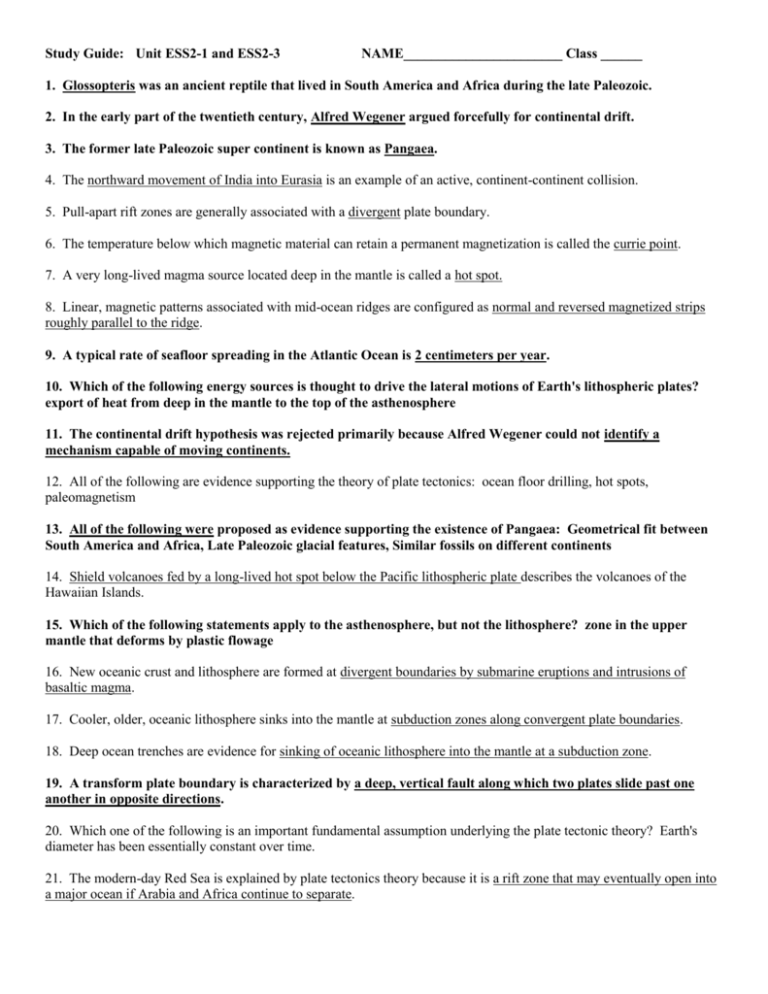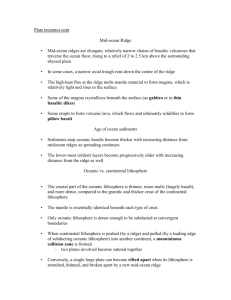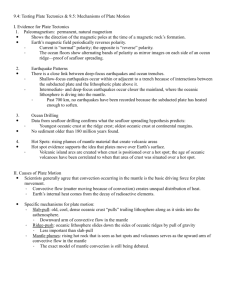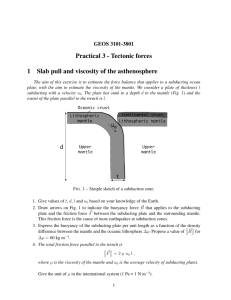study guide ESS2-1 and ESS2-3
advertisement

Study Guide: Unit ESS2-1 and ESS2-3 NAME_______________________ Class ______ 1. Glossopteris was an ancient reptile that lived in South America and Africa during the late Paleozoic. 2. In the early part of the twentieth century, Alfred Wegener argued forcefully for continental drift. 3. The former late Paleozoic super continent is known as Pangaea. 4. The northward movement of India into Eurasia is an example of an active, continent-continent collision. 5. Pull-apart rift zones are generally associated with a divergent plate boundary. 6. The temperature below which magnetic material can retain a permanent magnetization is called the currie point. 7. A very long-lived magma source located deep in the mantle is called a hot spot. 8. Linear, magnetic patterns associated with mid-ocean ridges are configured as normal and reversed magnetized strips roughly parallel to the ridge. 9. A typical rate of seafloor spreading in the Atlantic Ocean is 2 centimeters per year. 10. Which of the following energy sources is thought to drive the lateral motions of Earth's lithospheric plates? export of heat from deep in the mantle to the top of the asthenosphere 11. The continental drift hypothesis was rejected primarily because Alfred Wegener could not identify a mechanism capable of moving continents. 12. All of the following are evidence supporting the theory of plate tectonics: ocean floor drilling, hot spots, paleomagnetism 13. All of the following were proposed as evidence supporting the existence of Pangaea: Geometrical fit between South America and Africa, Late Paleozoic glacial features, Similar fossils on different continents 14. Shield volcanoes fed by a long-lived hot spot below the Pacific lithospheric plate describes the volcanoes of the Hawaiian Islands. 15. Which of the following statements apply to the asthenosphere, but not the lithosphere? zone in the upper mantle that deforms by plastic flowage 16. New oceanic crust and lithosphere are formed at divergent boundaries by submarine eruptions and intrusions of basaltic magma. 17. Cooler, older, oceanic lithosphere sinks into the mantle at subduction zones along convergent plate boundaries. 18. Deep ocean trenches are evidence for sinking of oceanic lithosphere into the mantle at a subduction zone. 19. A transform plate boundary is characterized by a deep, vertical fault along which two plates slide past one another in opposite directions. 20. Which one of the following is an important fundamental assumption underlying the plate tectonic theory? Earth's diameter has been essentially constant over time. 21. The modern-day Red Sea is explained by plate tectonics theory because it is a rift zone that may eventually open into a major ocean if Arabia and Africa continue to separate. 22. Mount St. Helens and the other Cascade volcanoes are young, active stratovolcanoes built on a continental margin above a sinking slab of oceanic lithosphere (subduction zone). 23. The volcanoes and deep valleys of east Africa are related to a continental rift along which parts of the African continent are beginning to slowly separate. 24. The Aleutian Islands occur at a convergent boundary on a volcanic island arc above a northward-subducting Pacific plate. 25. Lines of earthquake epicenters most effectively outline the edges of the lithospheric plates. 26. Deep-oceanic trenches are most abundant around the rim of the pacific ocean basin. 27. Vine and Matthews first related the symmetrical magnetic patterns in seafloor basalts to seafloor spreading at a midocean ridge. 28. Early results of the Deep Sea Drilling Project clearly justified the conclusion that the ocean basins are relatively young. 29. Divergent boundaries are where two plates move apart, resulting in up-welling of material from the mantle to create new seafloor. 30. Convergent boundaries are where two plates move together, resulting in oceanic lithosphere descending beneath an overriding plate, eventually to be reabsorbed into the mantle. 31. Slab pull results because old slabs of oceanic lithosphere are more dense than the underlying asthenosphere and hence “sink like a rock.” 32. Ridge push is a gravity-driven mechanism resulting from the elevated position of the oceanic ridge, which causes slabs of lithosphere to “slide” down the flanks of the ridge. Matching. Match the plate boundary with the appropriate phrase. A. convergent B. transform C. divergent 29. plates are moving apart from one another (A) 30. plates are sliding past one another horizontally (B) 31. this boundary is normally devoid of volcanism (B) 32. where lithosphere is sinking into the mantle (A) 33. characterized by basaltic volcanism and seafloor spreading (C) 34. characterized by arcs of stratovolcanoes and deep-ocean trenches (A) 35. the Mid-Atlantic Ridge (C) 36. where subduction zones occur (A) 37. the San Andreas fault (B) 38. the west coast of South America (A) 39. where the mid ocean ridge is moving apart (C)








